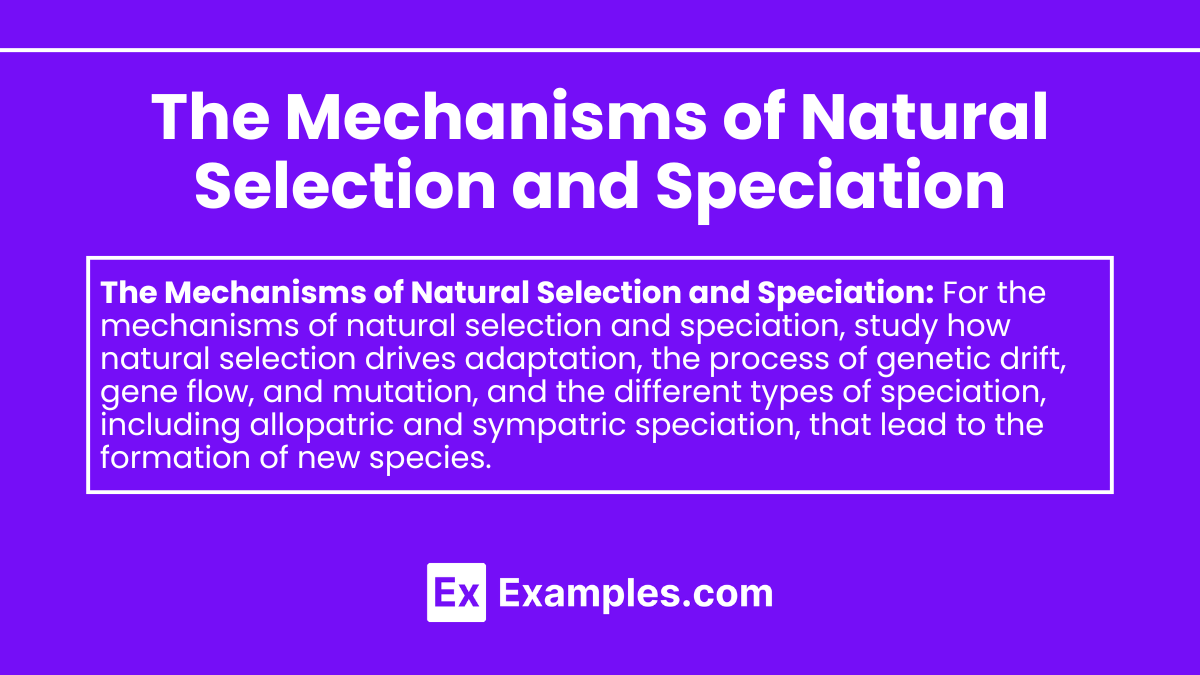In AP Biology, studying the mechanisms of natural selection and speciation is essential for understanding evolution. Natural selection drives the adaptation of organisms through differential survival and reproduction, while speciation explains how new species arise through processes like geographic isolation and genetic divergence. By examining these mechanisms, we can comprehend how biodiversity evolves and how distinct species form, providing a foundational understanding of biological diversity and evolutionary theory.
Learning Objectives
You will explore how natural selection drives evolutionary changes within populations, understand the role of genetic variation and mutation, and analyze the effects of different types of selection (stabilizing, directional, and disruptive). You will examine processes leading to speciation, including geographic and reproductive isolation, and recognize how new species arise. These objectives will help you grasp the mechanisms underlying natural selection and speciation, essential topics in AP Biology.
Natural Selection
Definition: Natural selection is the process by which organisms with favorable traits are more likely to survive and reproduce, passing those traits to the next generation.
Key Principles of Natural Selection
Variation: Individuals in a population vary in their traits.
Inheritance: Traits are heritable and can be passed from parents to offspring.
Overproduction: More offspring are produced than can survive.
Differential Survival and Reproduction: Individuals with advantageous traits are more likely to survive and reproduce.
Types of Natural Selection
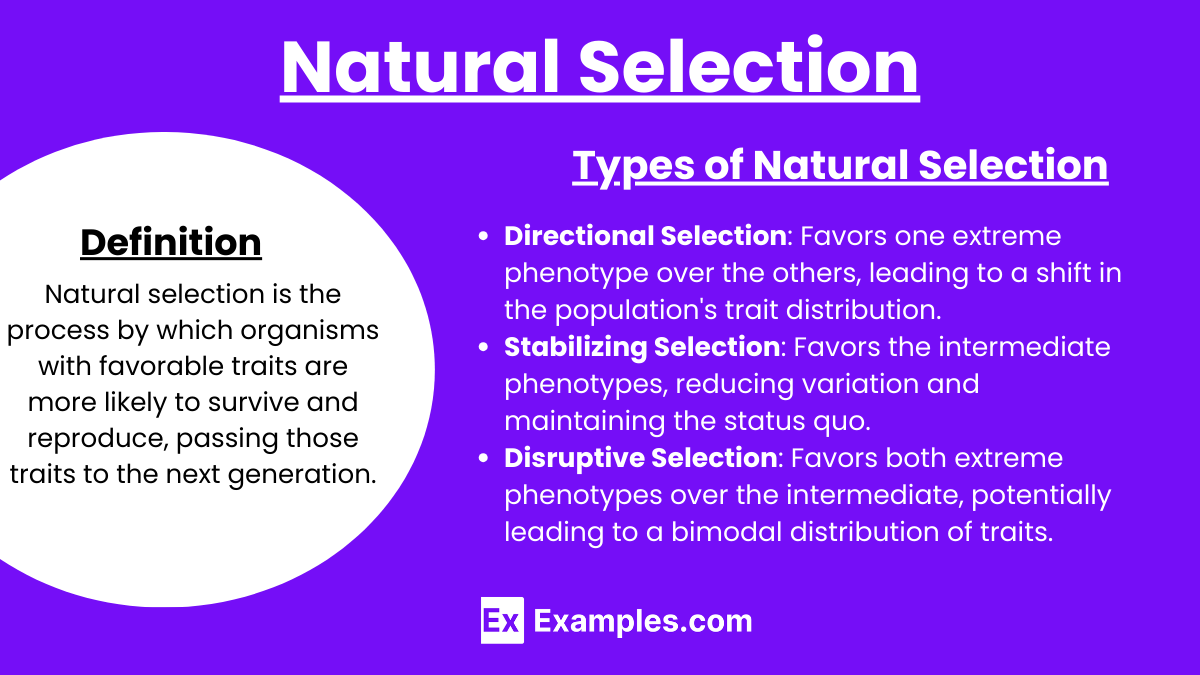
Directional Selection: Favors one extreme phenotype over the others, leading to a shift in the population's trait distribution.
Stabilizing Selection: Favors the intermediate phenotypes, reducing variation and maintaining the status quo.
Disruptive Selection: Favors both extreme phenotypes over the intermediate, potentially leading to a bimodal distribution of traits.
Examples of Natural Selection
Peppered Moth (Biston betularia): Industrial melanism in peppered moths during the Industrial Revolution.
Antibiotic Resistance in Bacteria: The evolution of bacteria that are resistant to antibiotics due to the selective pressure of antibiotic use.
Speciation
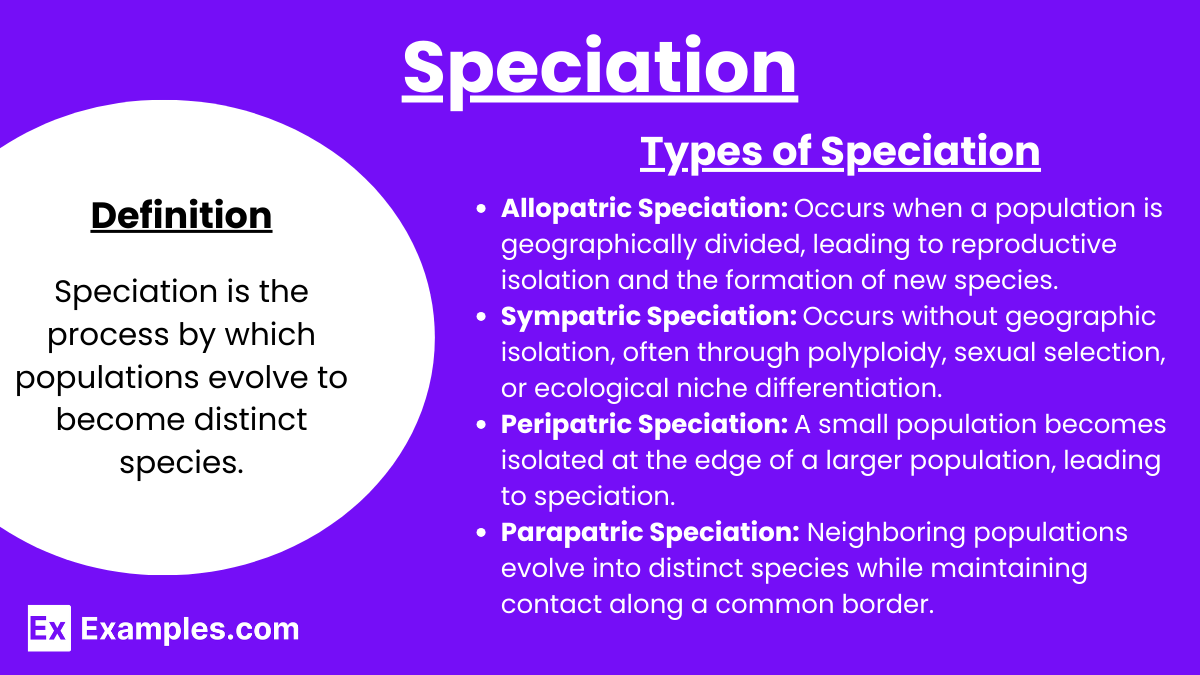
Definition: Speciation is the process by which populations evolve to become distinct species.
Types of Speciation
Allopatric Speciation: Occurs when a population is geographically divided, leading to reproductive isolation and the formation of new species.
Example: The formation of different species of Darwin’s finches on the Galápagos Islands due to geographic isolation.
Sympatric Speciation: Occurs without geographic isolation, often through polyploidy, sexual selection, or ecological niche differentiation.
Example: Cichlid fish in African lakes, where speciation occurs due to variations in feeding habits and mating preferences.
Peripatric Speciation: A small population becomes isolated at the edge of a larger population, leading to speciation.
Example: The evolution of polar bears from brown bears.
Parapatric Speciation: Neighboring populations evolve into distinct species while maintaining contact along a common border.
Example: The grass species Anthoxanthum odoratum, which exhibits differentiation in populations growing on contaminated and non-contaminated soils.
Mechanisms Promoting Speciation
Reproductive Isolation
Prezygotic Barriers: Prevent mating or fertilization between species.
Habitat Isolation: Different habitats prevent encounters.
Temporal Isolation: Different breeding times.
Behavioral Isolation: Different courtship behaviors.
Mechanical Isolation: Incompatible reproductive structures.
Gametic Isolation: Sperm and egg cannot fuse.
Postzygotic Barriers: Prevent hybrid offspring from becoming viable or fertile adults.
Hybrid Inviability: Hybrids do not develop properly or die early.
Hybrid Sterility: Hybrids are sterile (e.g., mule).
Hybrid Breakdown: Hybrids are fertile but their offspring are inviable or sterile.
Genetic Mechanisms Underlying Speciation
Genetic Drift: Random changes in allele frequencies, more pronounced in small populations.
Gene Flow: Movement of genes between populations can prevent speciation but can also introduce new genetic material that leads to speciation under certain conditions.
Mutation: Introduction of new genetic variations can lead to speciation.
Selection: Differential survival and reproduction can lead to the divergence of populations.
Patterns of Evolution
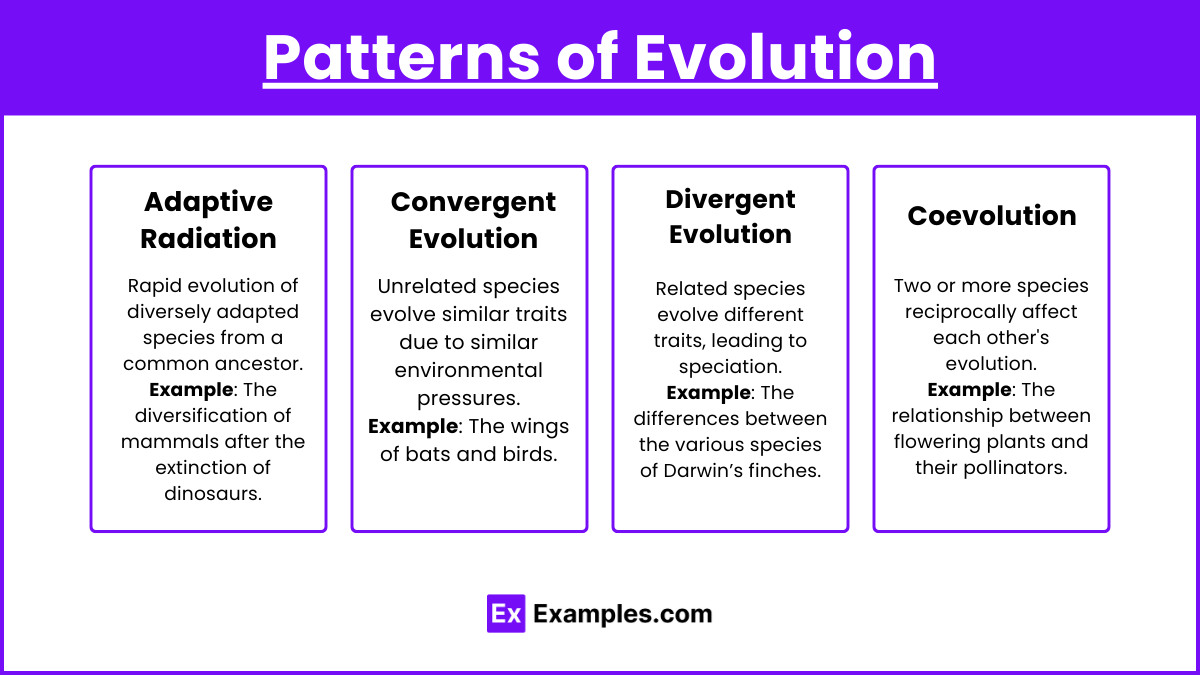
Adaptive Radiation
Definition: Rapid evolution of diversely adapted species from a common ancestor.
Example: The diversification of mammals after the extinction of dinosaurs.
Convergent Evolution
Definition: Unrelated species evolve similar traits due to similar environmental pressures.
Example: The wings of bats and birds.
Divergent Evolution
Definition: Related species evolve different traits, leading to speciation.
Example: The differences between the various species of Darwin’s finches.
Coevolution
Definition: Two or more species reciprocally affect each other's evolution.
Example: The relationship between flowering plants and their pollinators.
Human Impact on Speciation
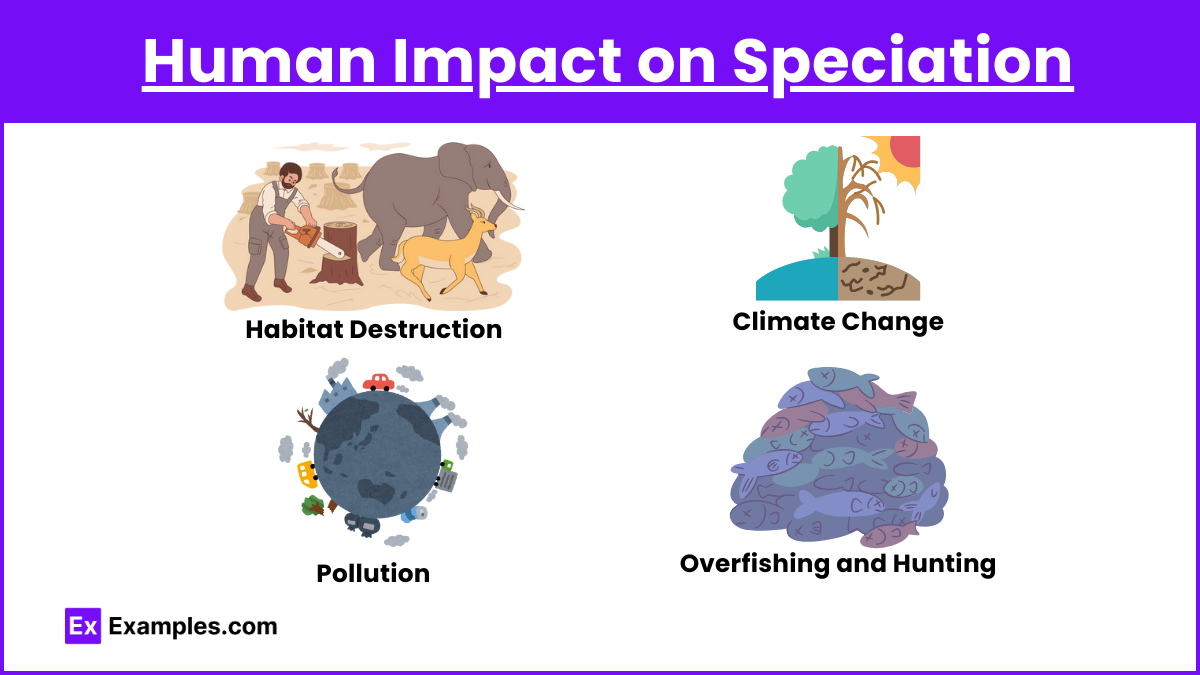
Habitat Destruction: Leads to allopatric speciation by fragmenting populations.
Climate Change: Alters habitats and can lead to new selective pressures.
Pollution: Can create new environments for adaptive radiation.
Overfishing and Hunting: Can alter population structures and lead to evolutionary changes.
Summary Table of Mechanisms and Examples
Mechanism | Description | Examples |
|---|---|---|
Natural Selection | Differential survival and reproduction of individuals | Peppered moths, antibiotic-resistant bacteria |
Allopatric Speciation | Geographic isolation leads to speciation | Darwin’s finches, squirrel species on opposite sides of the Grand Canyon |
Sympatric Speciation | Speciation without geographic isolation | Cichlid fish, apple maggot flies |
Peripatric Speciation | Small population isolated at edge | Polar bears evolving from brown bears |
Parapatric Speciation | Neighboring populations evolve into distinct species | Grass species on contaminated vs. non-contaminated soils |
Adaptive Radiation | Rapid diversification from a common ancestor | Mammalian diversification post-dinosaur extinction |
Convergent Evolution | Unrelated species evolve similar traits | Wings of bats and birds |
Divergent Evolution | Related species evolve different traits | Darwin’s finches |
Coevolution | Reciprocal evolutionary influence | Flowering plants and pollinators |
Examples
Example 1: Antibiotic Resistance in Bacteria
Bacteria exposed to antibiotics often develop resistance through natural selection. Resistant bacteria survive and reproduce, passing on their resistance genes. Over time, the population evolves to be predominantly resistant to the antibiotic.
Example 2: Darwin's Finches
On the Galápagos Islands, finches have evolved different beak shapes to exploit various food sources. This adaptive radiation is a result of natural selection driving speciation based on available resources.
Example 3: Peppered Moths
During the Industrial Revolution, dark-colored peppered moths became more common than light-colored moths in polluted areas. The dark coloration provided better camouflage against soot-covered trees, leading to higher survival rates and reproduction.
Example 4: Sickle Cell Anemia and Malaria
In regions where malaria is prevalent, individuals with one copy of the sickle cell allele have a survival advantage. This heterozygote advantage maintains the sickle cell allele in the population, illustrating natural selection.
Example 5: Allopatric Speciation in Squirrels
The formation of the Grand Canyon created a geographic barrier that separated squirrel populations. Over time, these populations evolved into distinct species due to lack of gene flow and different selective pressures in their respective environments.
Multiple Choice Questions
Question 1: Which of the following is an example of natural selection in action?
A. The development of new species due to geographic isolation
B. The survival of bacteria resistant to antibiotics
C. The high genetic similarity between humans and chimpanzees
D. The presence of homologous structures in different species
Answer: B. The survival of bacteria resistant to antibiotics
Explanation: The survival and reproduction of antibiotic-resistant bacteria exemplify natural selection, where the advantageous trait (resistance) increases in frequency within the population.
Question 2: What does the term "adaptive radiation" refer to?
A. The gradual change of species over time
B. The evolution of new species from a common ancestor in different environments
C. The development of similar traits in unrelated species
D. The genetic similarity between closely related species
Answer: B. The evolution of new species from a common ancestor in different environments
Explanation: Adaptive radiation occurs when a single ancestral species evolves into multiple distinct species, each adapted to different environments or ecological niches, as seen in Darwin's finches.
Question 3: How does geographic isolation contribute to speciation?
A. By increasing genetic diversity within a single population
B. By allowing gene flow between separated populations
C. By creating different selective pressures in isolated populations
D. By reducing the mutation rate in isolated populations
Answer: C. By creating different selective pressures in isolated populations
Explanation: Geographic isolation prevents gene flow between populations, allowing them to evolve independently. Different selective pressures in each environment can lead to the development of distinct species, a process known as allopatric speciation.

